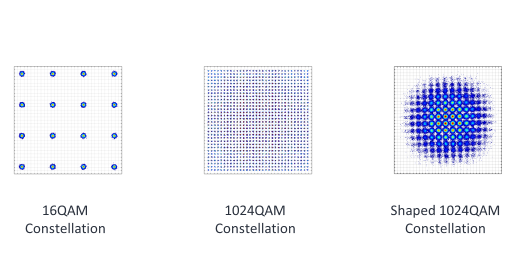Infinera has set two industry milestones for advanced coherent technologies that take the capacity of optical transport networks to the next level: 100Gbaud transmission and 1024-QAM (quadrature amplitude modulation).
These improvements are designed to deliver the highest possible capacity on a single wavelength, helping operators extract the best performance from their optical transport networks, the company said. The results were presented as post-deadline papers – late breaking results that are considered significant – at the 2017 European Conference on Optical Communications (ECOC) last month.
Baud rate is the speed at which data symbols are transmitted. With the advent of coherent transmission, baud rate and data rate are no longer the same because one symbol can represent more than one bit. A typical baud rate in commercial equipment being deployed is 32Gbaud which, when combined with QAM carrying 4 bits per symbol, results in 100Gb/s transmission.
While 66Gbaud components have recently reached the market, Infinera has gone further to showcase 100Gbaud and 32QAM to achieve a terabit data rate on a single wavelength, which it claims is an industry first.
The use of photonic integration is significant in enabling this result, according to Geoff Bennett, director of solutions and technology for Infinera. As baud rates increase, placing optical components closer together on an integrated chip reduces component size and power while increasing reliability.
“As baud rates increase there is a very high value in being able to locate optical components as close together as possible, and the ultimate limit is for those components (i.e. laser, modulator, waveguides) to be integrated onto the same chip, using the same material – in this case indium phosphide. Silicon germanium drivers were also integrated into the package,” he explained
In the second paper, Infinera showcased the possibilities of the higher-order modulation scheme of 1024-QAM using advanced constellation-shaping algorithms – an increasingly popular tool in the coherent toolbox (see for example, Nokia Bell Labs, T-Labs and Technical University of Munich test drive novel modulation scheme) – and Nyquist subcarriers, where wavelengths are squeezed as close as possible to each other to maximise the data rate.
The Infinera test bed used 66Gbaud at 1024-QAM to reach a coded bit rate of 1.32Tb/s. Constellation shaping was then applied to yield a net bit rate of 680Gb/s and a spectral efficiency of 9.35 b/s/Hz over a distance of 400km, also an industry first according to the company.

Figure: Comparing 16QAM, 1024QAM, and a Shaped 1024QAM Constellation
For 1024QAM, there are 1024 independent symbols, each carrying 10 bits per symbol, assuming each symbol is given an equal chance of being transmitted through the system. However, constellation shaping constrains the chances of certain symbols being transmitted in order to optimise transmission capacity. Lower-power symbols, which suffer less degradation, have a greater chance of being transmitted than the higher-power symbols. What this ultimately achieves is increased spacing between the symbols, thus making the shaped format less sensitive to noise.
Longer reaches can be achieved, but the trade-off is reduced transmission capacity. “The big advantage is that the noise tolerance can be adaptively tailored to match the signal-to-noise ratio of any given transmission link,” Bennett said. In other words, constellation shaping makes it possible to maximise the data rate for the optical budget of a given fibre path.
The optical reach for 1024QAM will be relatively short – but it could hit a sweet spot for data centre interconnect (DCI) customers who consume ever-increasing amounts of capacity over shorter distances.
These two papers are technology demonstrations intended to show what kind of technologies will be important in future products, according to Infinera. The company says its fifth-generation Infinite Capacity Engine (ICE5) is targeting 600Gb/s per wavelength and its sixth generation, will target at least 800Gb/s per wavelength.

